Lodged Sugarcane/Crop Dividers Interaction: Analysis of Robotic Sugarcane Harvester in Agriculture via a Rigid-Flexible Coupled Simulation Method
Abstract
1. Introduction
2. Working Principle of Spiral Crop Dividers
2.1. Working Principle and Components
2.2. Sugarcane Lodging Levels
3. Establishing System Dynamics and Simulation Design
3.1. Rigid-Flexible Coupling Modeling
3.2. Simulation Design
4. Results and Discussion
4.1. Validation Test
4.2. Analysis of the Lifting Process of LS
4.3. Change in VHC of LS
4.4. Analysis of the Average Value of the Maximum VHC
5. Conclusions
Author Contributions
Funding
Institutional Review Board Statement
Informed Consent Statement
Data Availability Statement
Conflicts of Interest
References
- Sunil, K.M.; Tony, E.G.; Alan, C.H. Effect of blade oblique angle and cutting speed on cutting energy for energy cane stems. Biosyst. Eng. 2015, 133, 64–70. [Google Scholar]
- Rajan, B.; Jagdish, S.; Alison, M.L.; Ram, S.M.; Walaa, F.A.; Ahmed, G.; Akbar, H. Potassium and Water-Deficient Conditions Influence the Growth, Yield and Quality of Ratoon Sugarcane (Saccharum officinarum L.) in a Semi-Arid Agroecosystem. Agronomy 2021, 11, 2257. [Google Scholar]
- Salassi, M.E.; Breaux, J.B.; Naquin, C.J. Modeling within-season sugarcane growth for optimal harvest system selection. Agric. Syst. 2002, 73, 261–278. [Google Scholar] [CrossRef]
- Phoonthawee, S.; Nattinee, S.; Kamonthip, S. Sequential Injection System for Analysis of Degree Brix, Orthophosphate and pH in Raw Sugarcane Juice Applicable to Sugar Industry. Molecules 2021, 26, 6484. [Google Scholar]
- Wang, F.; Ma, S.; Xing, H.; Bai, J.; Ma, J.; Yang, Y.; Hu, J. Base cutting energy consumption for sugarcane stools using contra-rotating basecutters. Trans. ASABE 2021, 64, 221–230. [Google Scholar] [CrossRef]
- Stray, B.J.; Vuuren, J.H.; Bezuidenhout, C.N. An optimization-based seasonal sugarcane harvest scheduling decision support system for commercial growers in South Africa. Comput. Electron. Agric. 2012, 83, 21–31. [Google Scholar] [CrossRef]
- Kallaya, K.; Supachai, P. Integrating a multiple crop year routing design for sugarcane harvesters to plant a new crop. Comput. Electron. Agric. 2017, 136, 58–70. [Google Scholar]
- Mathanker, S.K.; Gan, H.; Buss, J.C.; Lawson, B.; Hansen, A.C.; Ting, K.C. Power requirements and field performance in harvesting energycane and sugarcane. Biomass Bioenergy 2015, 75, 227–234. [Google Scholar] [CrossRef]
- Lucas, A.S.G.; Rouverson, P.S.; Patricia, C.M.; Fanciele, M.C.; Cristiano, Z.; Antonio, T.S.O. Quality of multi-row harvesting in sugarcane plantations established from pre-sprouted seedlings and billet. Ind. Crop. Prod. 2019, 142, 111831. [Google Scholar]
- Ou, Y.; Malcolm, W.; Yang, D.; Liu, Q.; Zheng, D.; Wang, M.; Liu, H. Mechanization technology: The key to sugarcane production in China. Int. J. Agric. Biol. Eng. 2013, 6, 1–27. [Google Scholar]
- Xie, L.; Wang, J.; Cheng, S.; Zeng, B.; Yang, Z. Optimisation and finite element simulation of the chopping process for chopper sugarcane harvesting. Biosyst. Eng. 2018, 175, 19–26. [Google Scholar] [CrossRef]
- Xing, H.; Ma, S.; Wang, F.; Bai, J.; Ma, J. Aerodynamic Performance Evaluation of Sugarcane Harvester Extractor Based on CFD. Sugar Tech 2021, 23, 627–633. [Google Scholar] [CrossRef]
- Song, C.; Ou, Y. Design and Simulation Analysis of Two-stage Conical Helical Sugarcane Support Mechanism. J. Agric. Mech. Res. 2019, 41, 137–141, 147. [Google Scholar]
- Yang, W.; Zhao, W.; Liu, Y.; Chen, Y.; Yang, J. Simulation of forces acting on the cutter blade surfaces and root system of sugarcane using FEM and SPH coupled method. Comput. Electron. Agric. 2021, 180, 105893. [Google Scholar] [CrossRef]
- Marcelo, A.S.; Lucas, A.H.; Maria, M.P.S.; Gabriel, H.G.; Alexandrius, M.B.; Leandro, B. Base Cut Quality and Productivity of Mechanically Harvested Sugarcane. Sugar Tech Int. J. Sugar Crop. Relat. Ind. 2020, 22, 284–290. [Google Scholar]
- Deng, J.; Li, S.; Liang, S. Conceptual design and innovation on holding device of sugarcane harvester. Trans. Chin. Soc. Agric. Mach. 2003, 34, 58–61. [Google Scholar]
- Cortez, J.W.; Missio, C.; Barreto, A.K.G.; Silva, M.D.D.; Reis, G.N. Quality of sugarcane mechanized planting. Eng. Agric. 2016, 36, 1136–1144. [Google Scholar] [CrossRef][Green Version]
- Bai, J.; Ma, S.; Wang, F.; Xing, H.; Ma, J.; Wang, M. Performance of Crop Dividers with Reference to Harvesting Lodged Sugarcane. Sugar Tech 2020, 22, 812–819. [Google Scholar] [CrossRef]
- Mou, X. Design and Test on the Rake Bar Chain-Type Sugarcane Lifter; South China Agricultural University: Guangzhou, China, 2008. [Google Scholar]
- Bai, J.; Ma, S.; Wang, F.; Xing, H.; Ma, J.; Hu, J. Field test and evaluation on crop dividers of sugarcane chopper harvester. Int. J. Agric. Biol. Eng. 2021, 14, 118–122. [Google Scholar] [CrossRef]
- Gao, J.; Ou, Y. Theoretical study on spiral sugarcane lifting mechanism of sugarcane harvester and virtual prototype simulation. Trans. Can. Soc. Assoc. Exec. 2004, 20, 1–5. [Google Scholar]
- Gao, J.; Ou, Y.; Song, C.; Zhang, Y.; Qing, S. Study on Virtual Prototype of Spiral Sugarcane-lifting Organ Based on Physical Model. Trans. Confocal Scanning Acoust. Microsc. 2005, 36, 57–59. [Google Scholar]
- Song, C.; Ou, Y.; Liu, Q.; Wang, M. Experimental study on influencing factors of lifting quality for push-over-type sugarcane harvester. Trans. Can. Soc. Assoc. Exec. 2012, 28, 35–40. [Google Scholar]
- Song, C.; Ou, Y. Lifting effect of spiral sugarcane-lifting mechanism. J. Hunan Agric. Univ. 2004, 30, 569–571. [Google Scholar]
- Song, C.; Ou, Y.; Liu, Q.; Xie, F. Simulation and experiments of two-stage spiral sugarcane picking-up mechanism. Trans. Can. Soc. Assoc. Exec. 2011, 27, 106–110. [Google Scholar]
- Dong, Z.; Meng, Y.; Li, Y. Design of non-equidistant pitch sugarcane propping device. J. Agric. Mech. Res. 2010, 32, 80–84. [Google Scholar]
- Xie, F.; Ou, Y.; Liu, Q. Experiment of Combined-lifter Device for Sugarcane Harvester. Trans. Confocal Scanning Acoust. Microsc. 2011, 42, 94–98. [Google Scholar]
- Duan, T.; Wei, J.; Zhang, A.; Xu, Z.; Teik, C.L. Transmission error investigation of gearbox using rigid-flexible coupling dynamic model: Theoretical analysis and experiments. Mech. Mach. Theory 2021, 157, 104213. [Google Scholar] [CrossRef]
- Xia, H.; Zhen, W.; Chen, D.; Zeng, W. Rigid-flexible coupling contact action simulation study of the open mechanism on the ordinary multilayer fruit paper bag for fruit bagging. Comput. Electron. Agric. 2020, 173, 105414. [Google Scholar] [CrossRef]
- Liu, F.; Huang, H.; Li, B.; Hu, Y.; Jin, H. Design and analysis of a cable-driven rigid–flexible coupling parallel mechanism with variable stiffness. Mech. Mach. Theory 2020, 153, 104030. [Google Scholar] [CrossRef]
- De Paula Corrêdo, L.; Canata, T.F.; Maldaner, L.F.; de Jesus Alves de Lima, J.; Molin, J.P. Sugarcane Harvester for In-field Data Collection: State of the Art, Its Applicability and Future Perspectives. Sugar Tech 2021, 23, 1–14. [Google Scholar] [CrossRef]
- Hu, J.; Wang, J.; Hu, Y. Optimization of parameters for sugarcane lifter based on simulation of virtual prototype. J. Zhejiang Univ. 2014, 40, 111–118. [Google Scholar]
- Yang, T.; Bai, Z.; Li, Z.; Feng, N.; Chen, L. Intelligent Vehicle Lateral Control Method Based on Feed forward + Predictive LQR Algorithm. Actuators 2021, 10, 228. [Google Scholar] [CrossRef]
- Chen, L.; Li, Z.; Yang, J.; Song, Y. Lateral Stability Control of Four-Wheel-Drive Electric Vehicle Based on Coordinated Control of Torque Distribution and ESP Differential Braking. Actuators 2021, 10, 135. [Google Scholar] [CrossRef]
- Chen, L.; Ma, P.; Tian, J.; Liang, X. Prediction and optimization of lubrication performance for a transfer case based on computational fluid dynamics. Eng. Appl. Comput. Fluid Mech. 2019, 13, 1013–1023. [Google Scholar] [CrossRef]
- Zhang, Z.; Jia, X.H.; Yang, T.; Gu, Y.L.; Wang, W.W.; Chen, L.Q. Multi-objective optimization of lubricant volume in an ELSD considering thermal effects. Int. J. Therm. Sci. 2021, 164, 106884. [Google Scholar] [CrossRef]
- Xie, L.; Wang, J.; Cheng, S.; Zeng, B.; Yang, Z. Optimization and dynamic simulation of a conveying and top breaking system for whole-stalk sugarcane harvesters. Biosyst. Eng. 2020, 197, 156–169. [Google Scholar] [CrossRef]
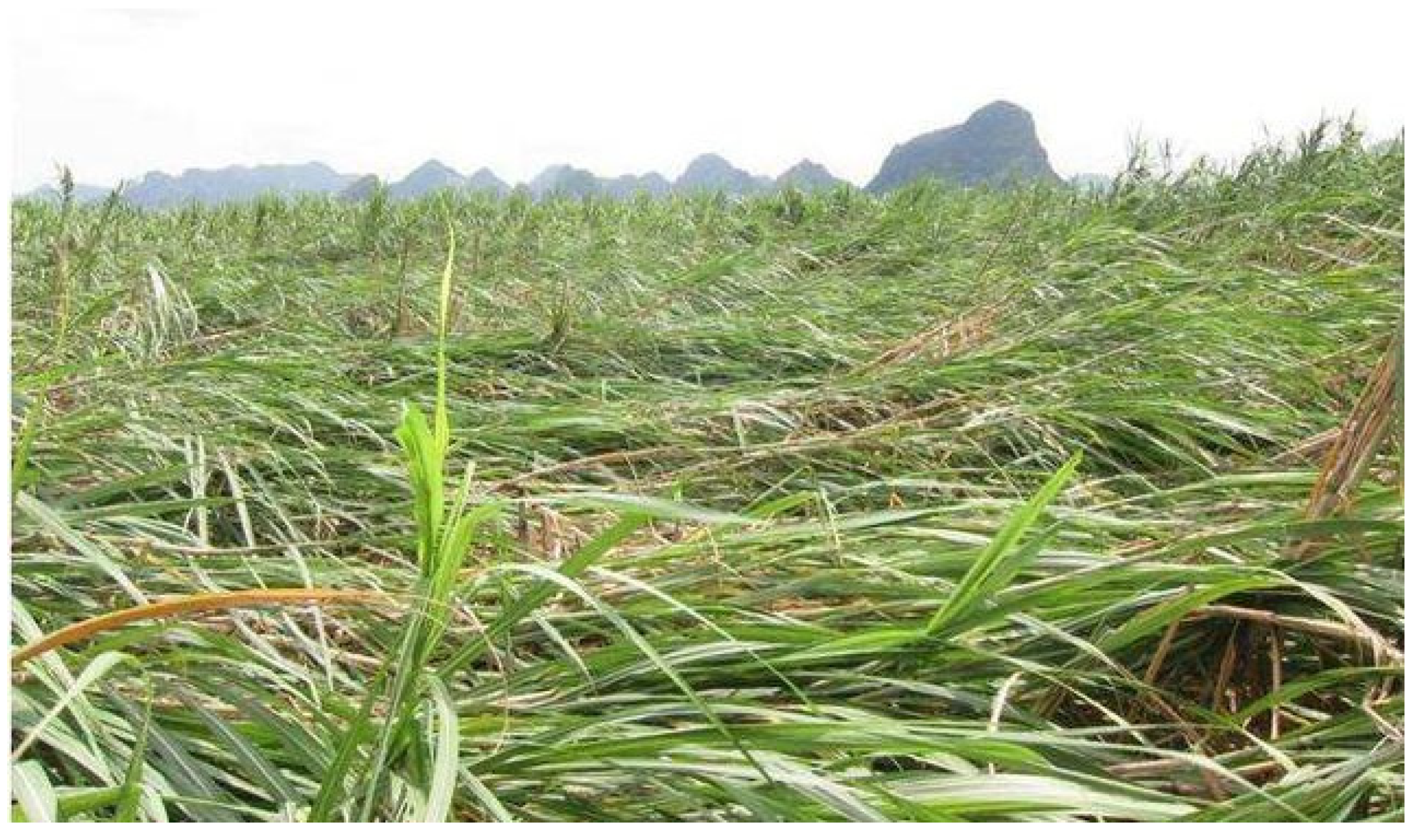
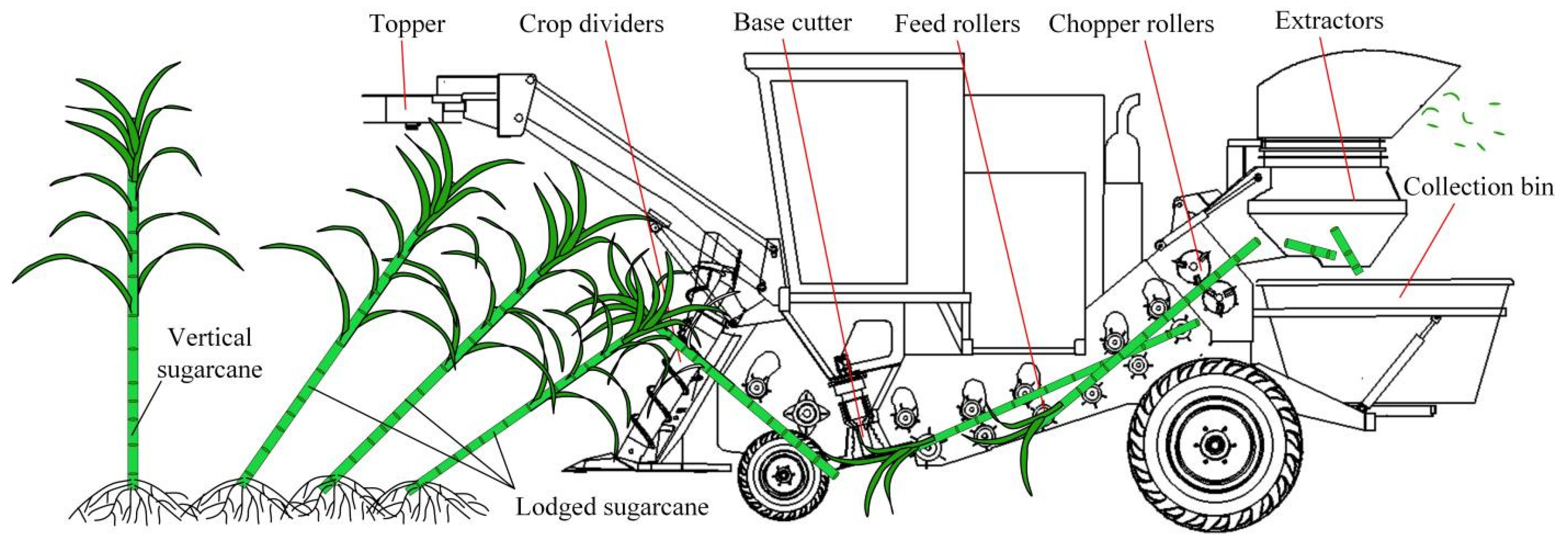
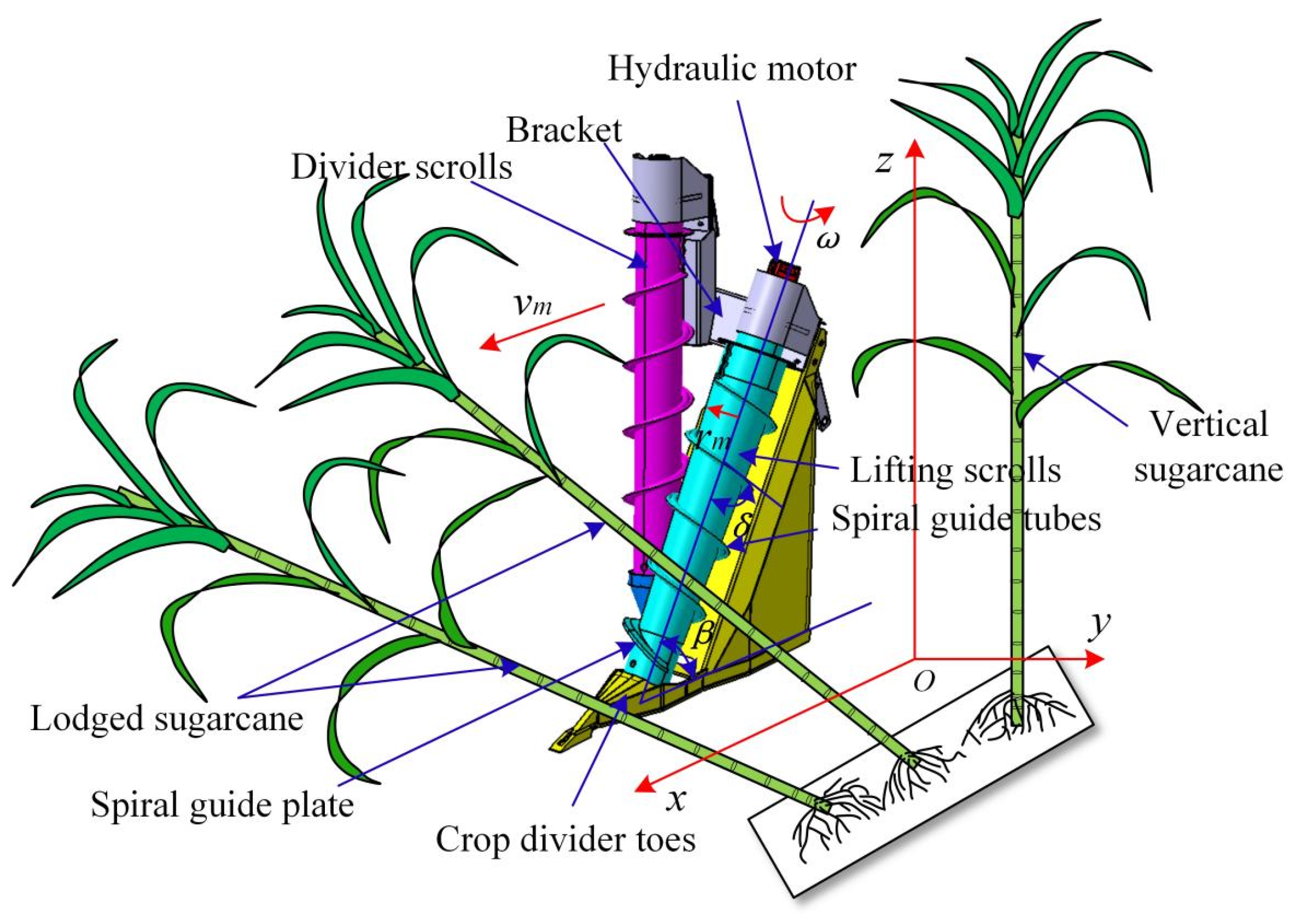
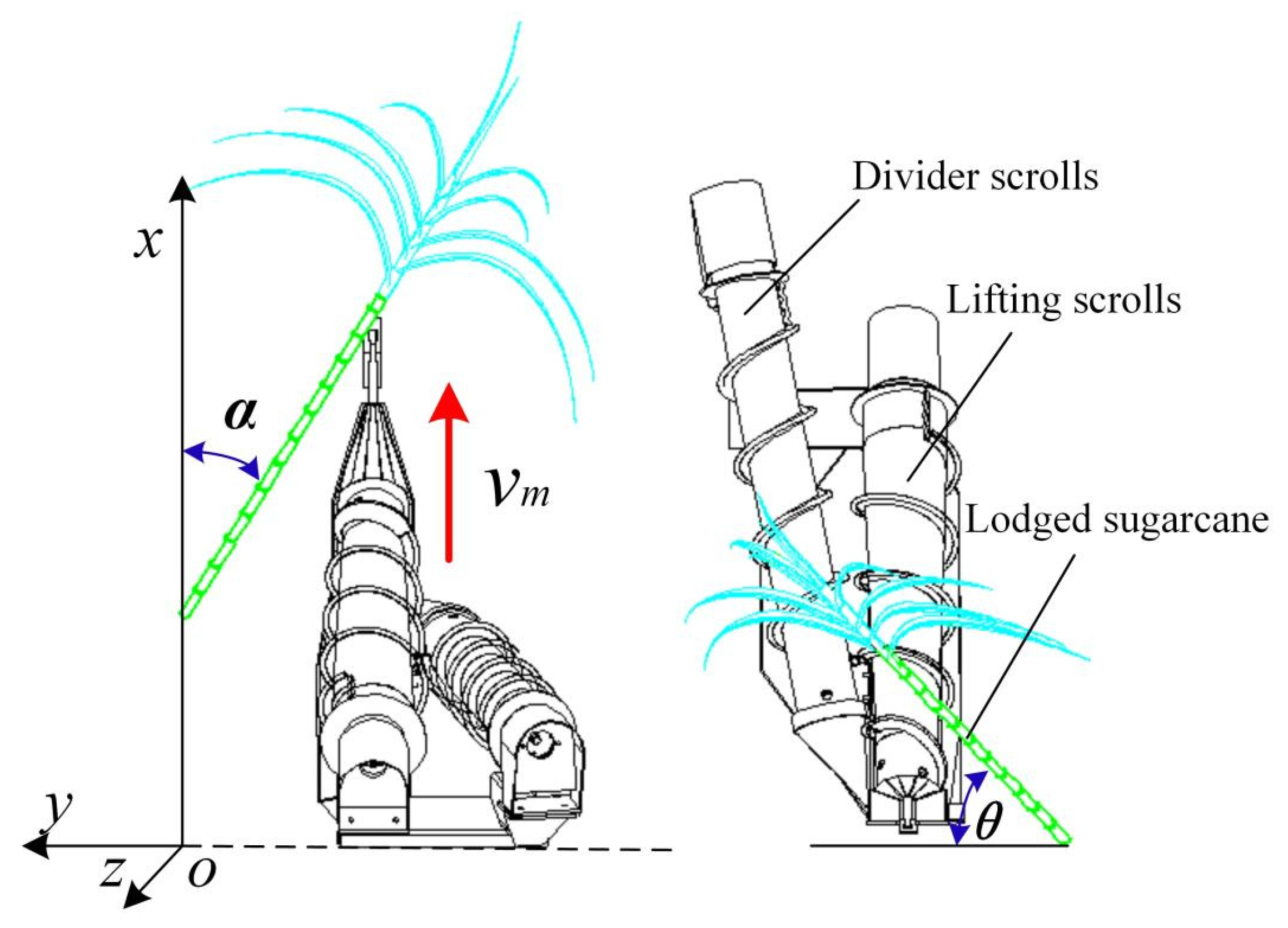
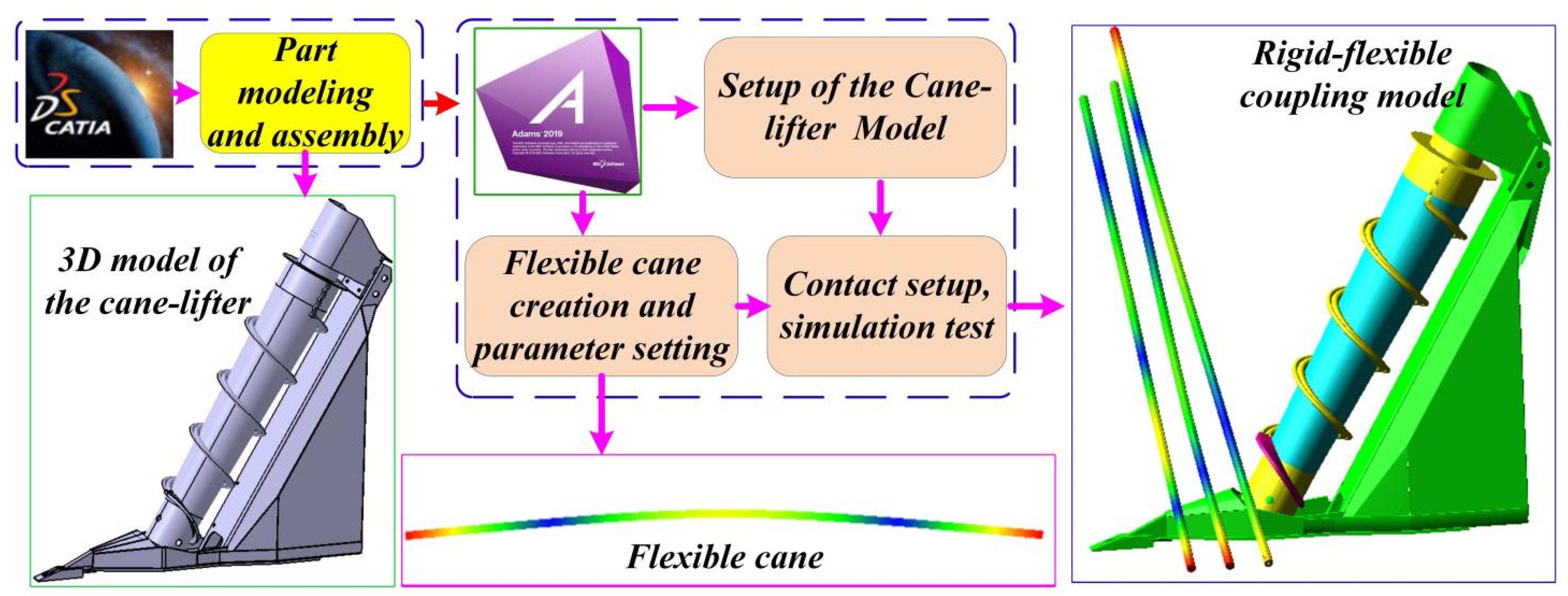
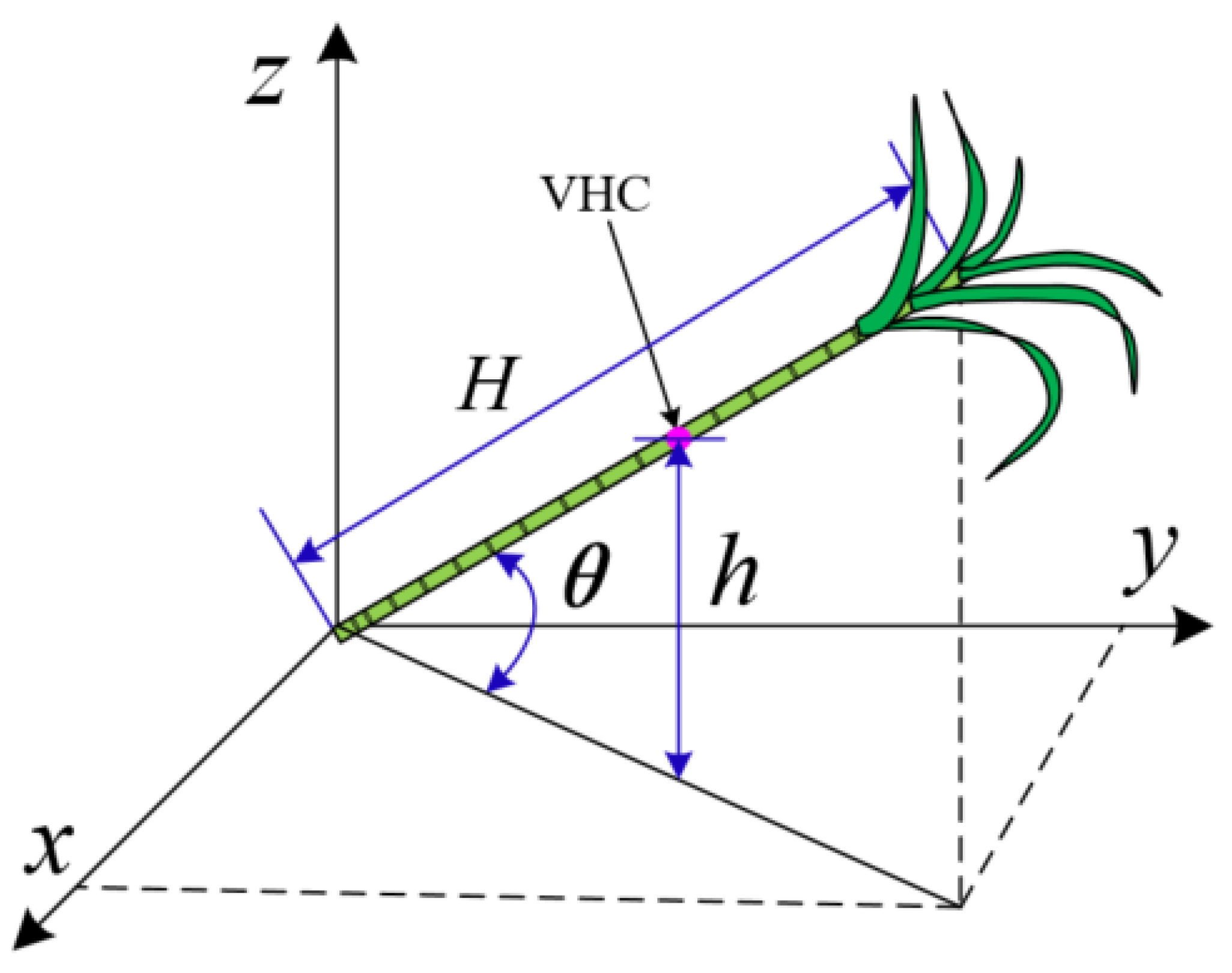
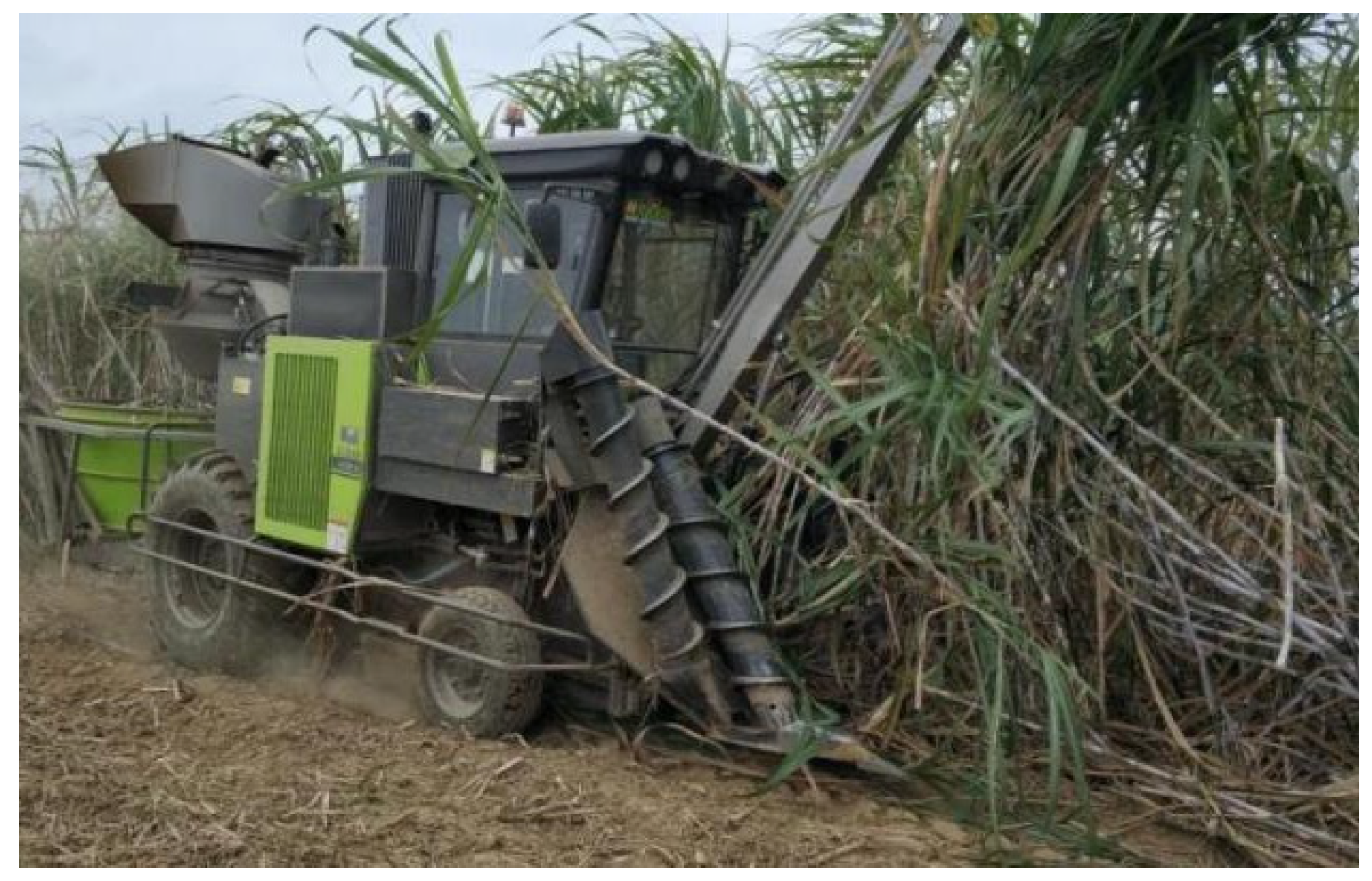
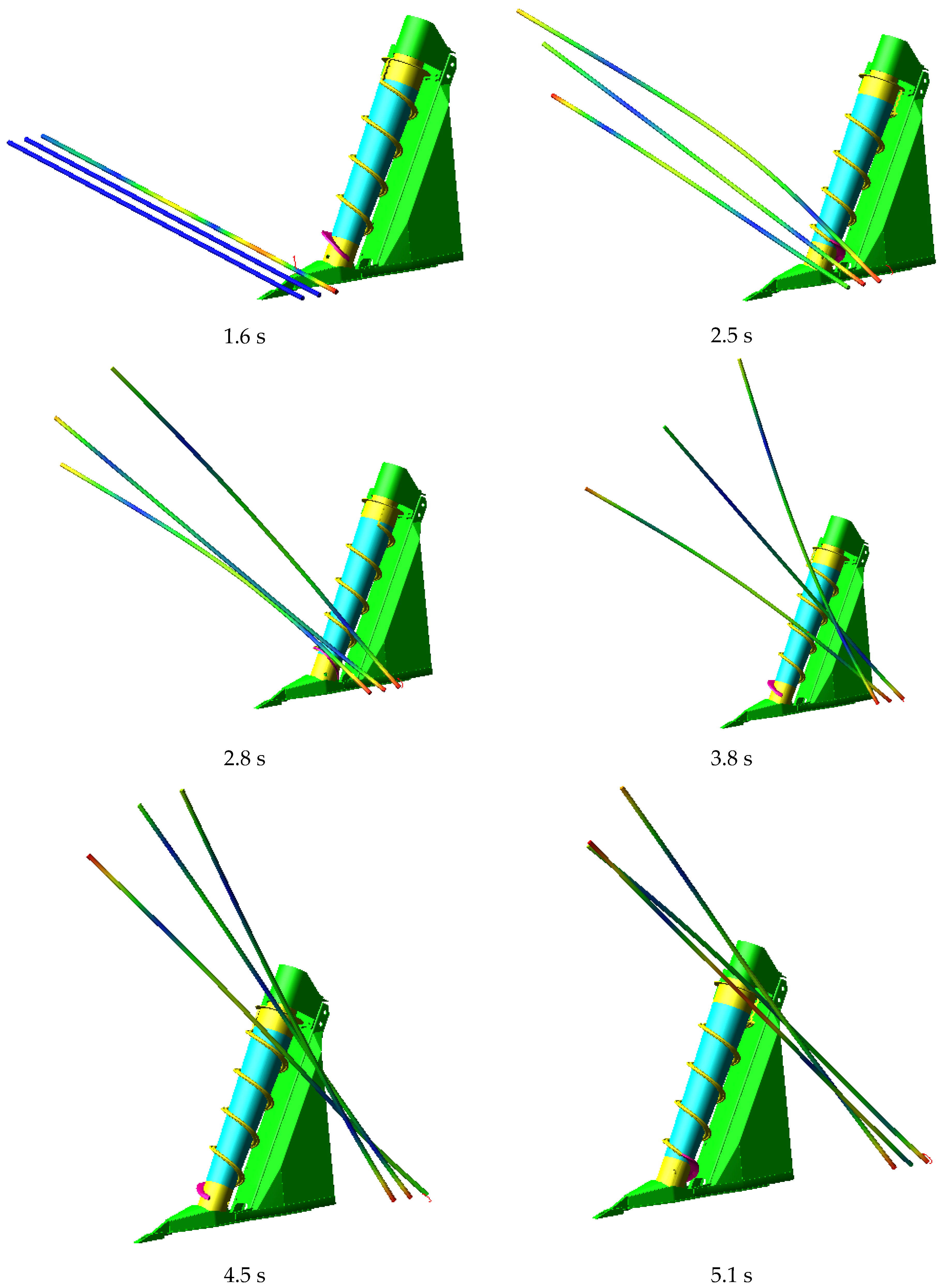
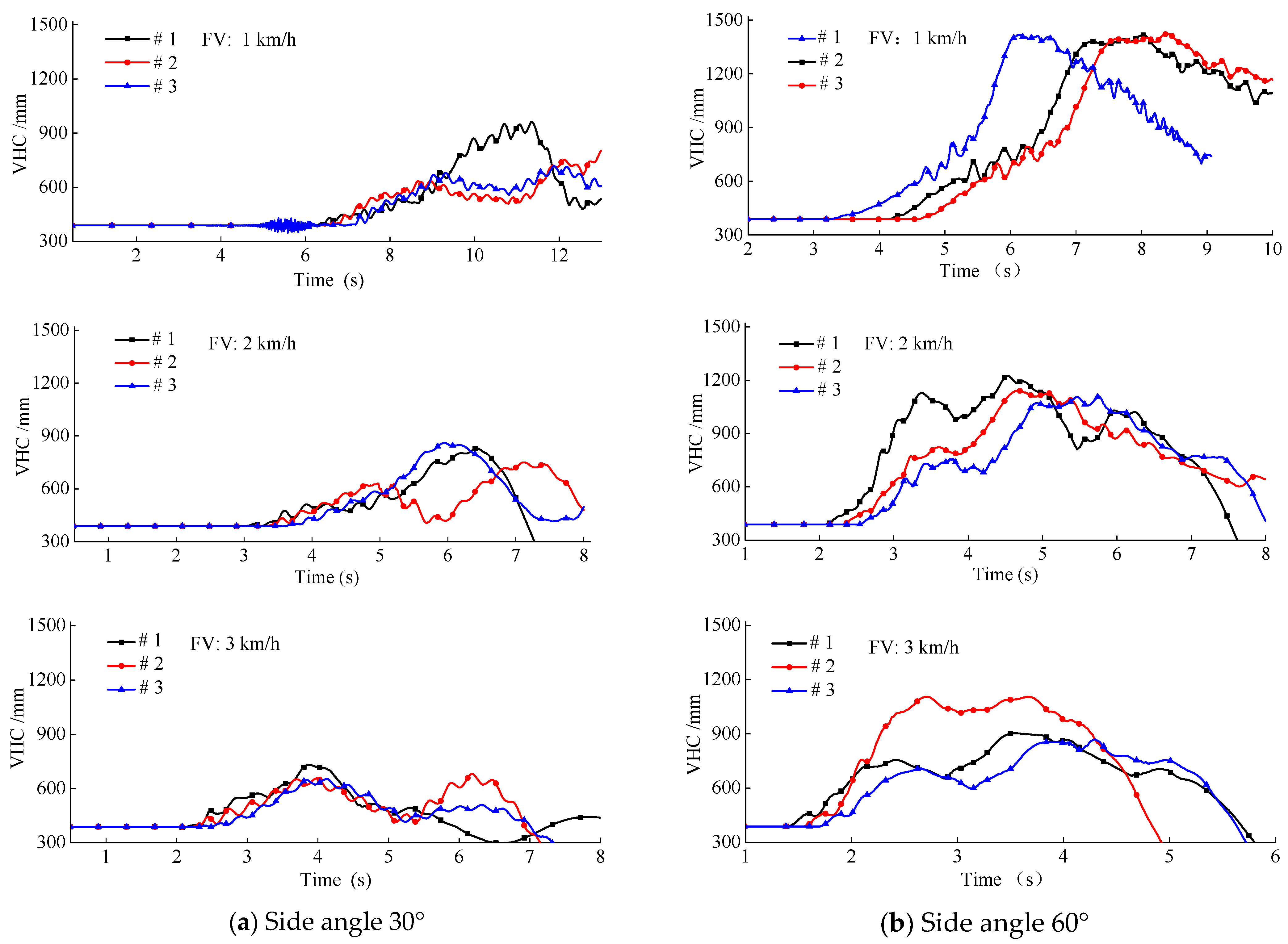
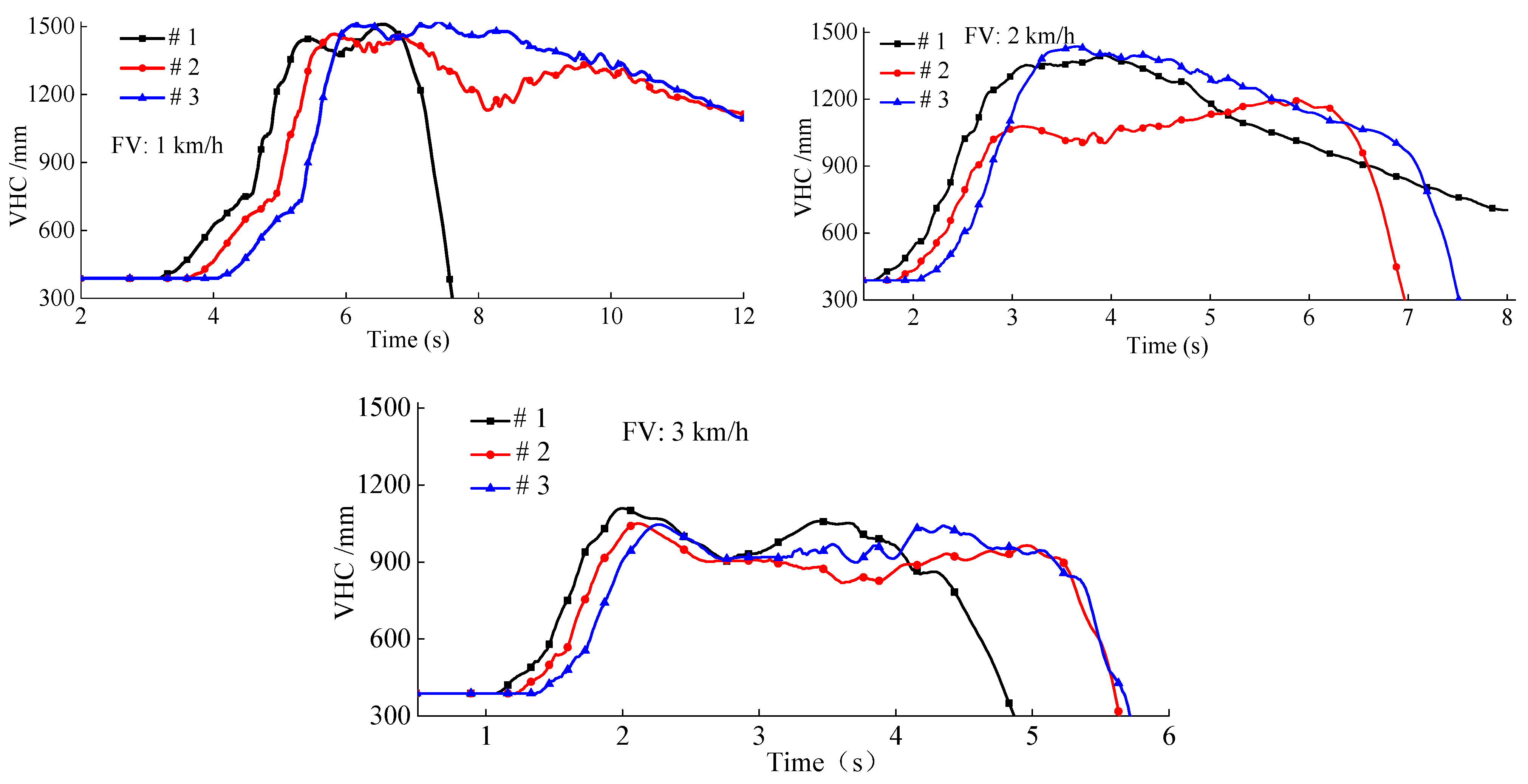
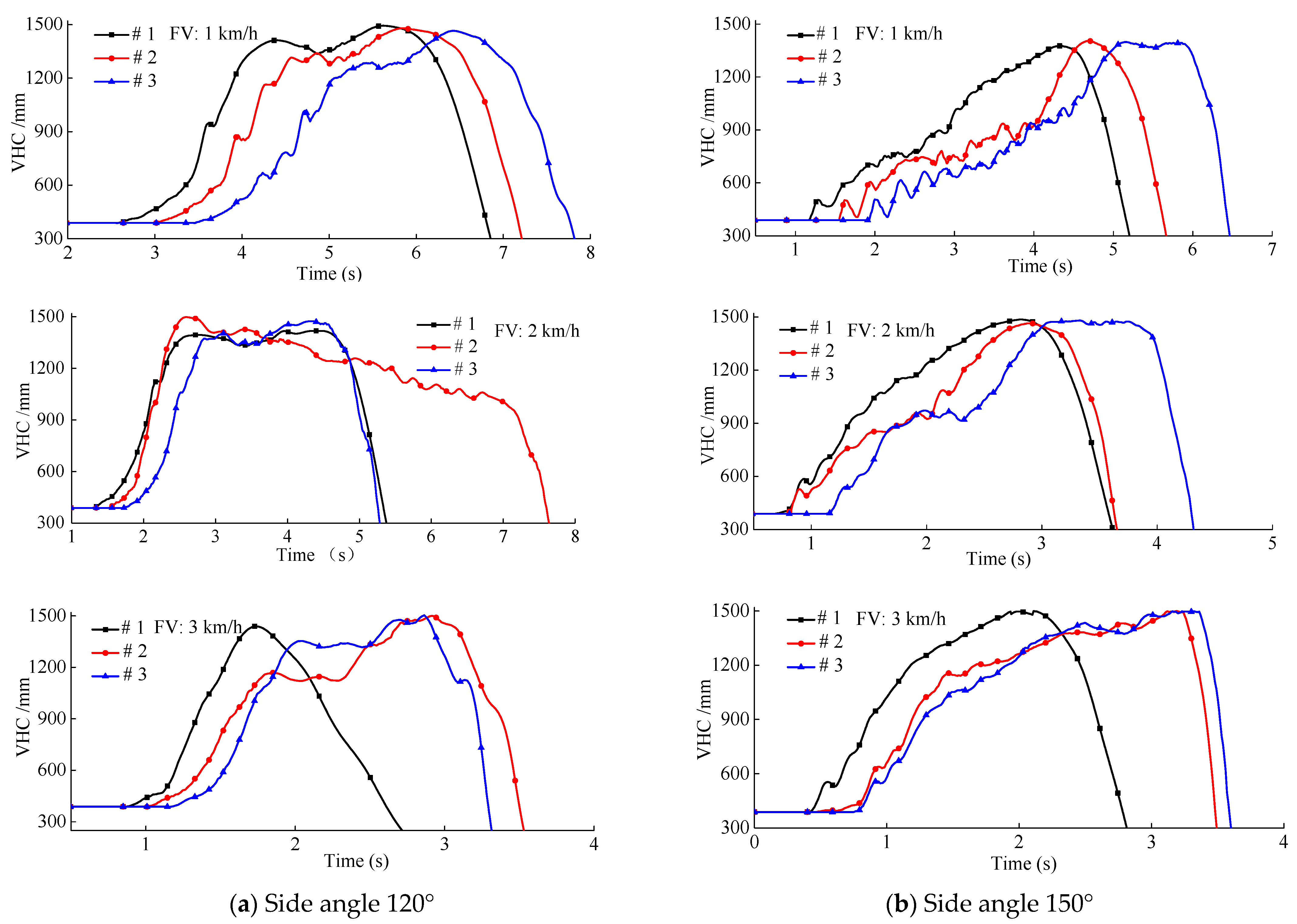
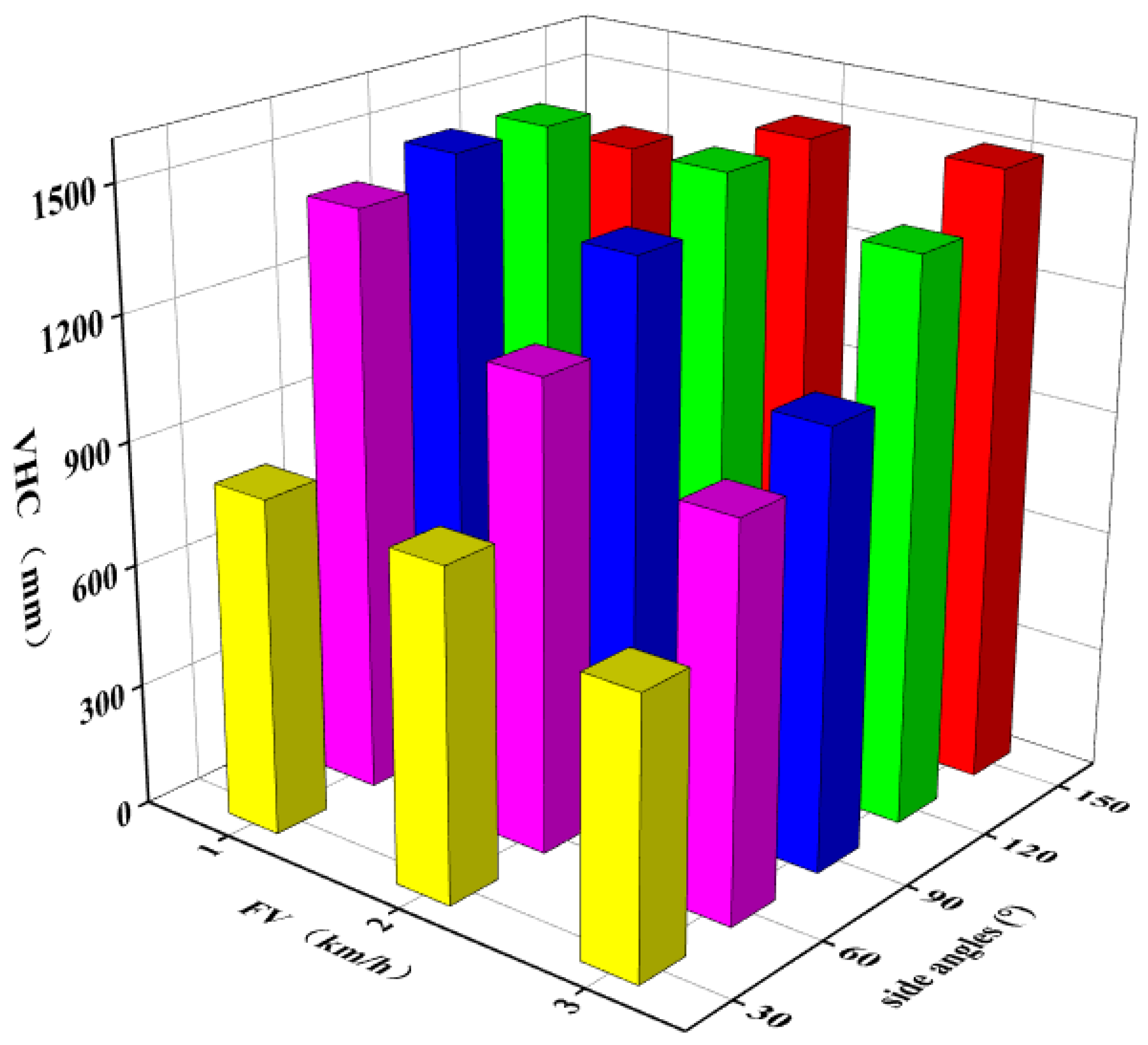
| Parameters | Values |
|---|---|
| Length of lifting scrolls/mm | 1300 |
| Pitch/mm | 250 |
| Inclination angle between lifting scrolls and horizontal plane/° | 60 |
| Length of sugarcane stalk/mm | 3000 |
| Diameter of sugarcane stalk/mm | 30 |
| Distance between adjacent sugarcane/mm | 125 |
| Poisson’s ratio | 0.33 |
| Elastic modulus/(N·mm−2) | 1195.44 |
| Distribution density/(kg·mm−3) | 1.1 × 10−6 |
| Stiffness/(N/mm) | 2855 |
| Force exponent | 1.1 |
| Maximum damping N/(m/s) | 0.57 |
| Penetration depth/mm | 0.1 |
| Static coefficient | 0.30 |
| Dynamic coefficient | 0.25 |
| Stiction transition velocity/(mm/s) | 0.10 |
| Friction transition velocity/(mm/s) | 10.00 |
| Side angles | 30° | 60° | 90° | 120° | 150° |
| Test values/mm | 757 | 1082 | 1263 | 1401 | 1417 |
| Simulation values/mm | 810 | 1145 | 1342 | 1463 | 1467 |
| Error rate/% | 7.00 | 5.82 | 8.84 | 4.43 | 3.53 |
Publisher’s Note: MDPI stays neutral with regard to jurisdictional claims in published maps and institutional affiliations. |
© 2022 by the authors. Licensee MDPI, Basel, Switzerland. This article is an open access article distributed under the terms and conditions of the Creative Commons Attribution (CC BY) license (https://creativecommons.org/licenses/by/4.0/).
Share and Cite
Wang, Q.; Zhang, Q.; Zhang, Y.; Zhou, G.; Li, Z.; Chen, L. Lodged Sugarcane/Crop Dividers Interaction: Analysis of Robotic Sugarcane Harvester in Agriculture via a Rigid-Flexible Coupled Simulation Method. Actuators 2022, 11, 23. https://doi.org/10.3390/act11010023
Wang Q, Zhang Q, Zhang Y, Zhou G, Li Z, Chen L. Lodged Sugarcane/Crop Dividers Interaction: Analysis of Robotic Sugarcane Harvester in Agriculture via a Rigid-Flexible Coupled Simulation Method. Actuators. 2022; 11(1):23. https://doi.org/10.3390/act11010023
Chicago/Turabian StyleWang, Qingqing, Qianwei Zhang, Yin Zhang, Guoan Zhou, Zhiqiang Li, and Liqing Chen. 2022. "Lodged Sugarcane/Crop Dividers Interaction: Analysis of Robotic Sugarcane Harvester in Agriculture via a Rigid-Flexible Coupled Simulation Method" Actuators 11, no. 1: 23. https://doi.org/10.3390/act11010023
APA StyleWang, Q., Zhang, Q., Zhang, Y., Zhou, G., Li, Z., & Chen, L. (2022). Lodged Sugarcane/Crop Dividers Interaction: Analysis of Robotic Sugarcane Harvester in Agriculture via a Rigid-Flexible Coupled Simulation Method. Actuators, 11(1), 23. https://doi.org/10.3390/act11010023







